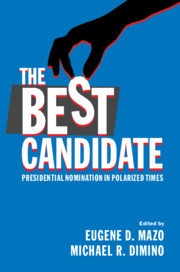Book contents
- The Best Candidate
- The Best Candidate
- Copyright page
- Dedication
- Contents
- Contributors
- Introduction
- 1 Presidential Selection: Historical, Institutional, and Democratic Perspectives
- 2 The Historical Development of the U.S. Presidential Nomination Process
- 3 Constitutional Law and the Presidential Nomination Process
- 4 Winnowing and Endorsing: Separating the Two Distinct Functions of Party Primaries
- 5 Simplifying Presidential Primaries
- 6 The Case for Standardizing Primary Voter Eligibility Rules
- 7 Primary Day: Why Presidential Nominees Should Be Chosen on a Single Day
- 8 A Eulogy for Caucuses
- 9 Floor Fight: Protecting the National Party Conventions from Manipulation
- 10 A Better Financing System? The Death and Possible Rebirth of the Presidential Nomination Public Financing Program
- 11 Campaign Finance Deregulation and the Hyperpolarization of Presidential Nominations in the Super PAC Era
- 12 Democratizing the Presidential Debates
- 13 The Influence of Technology on Presidential Primary Campaigns
- 14 Women and the Presidency
- 15 The Nomination of Presidential Candidates by Minor Political Parties
- 16 Reforming the Presidential Nominating Process: A Curmudgeon’s View
- Index
Introduction
Published online by Cambridge University Press: 10 September 2020
- The Best Candidate
- The Best Candidate
- Copyright page
- Dedication
- Contents
- Contributors
- Introduction
- 1 Presidential Selection: Historical, Institutional, and Democratic Perspectives
- 2 The Historical Development of the U.S. Presidential Nomination Process
- 3 Constitutional Law and the Presidential Nomination Process
- 4 Winnowing and Endorsing: Separating the Two Distinct Functions of Party Primaries
- 5 Simplifying Presidential Primaries
- 6 The Case for Standardizing Primary Voter Eligibility Rules
- 7 Primary Day: Why Presidential Nominees Should Be Chosen on a Single Day
- 8 A Eulogy for Caucuses
- 9 Floor Fight: Protecting the National Party Conventions from Manipulation
- 10 A Better Financing System? The Death and Possible Rebirth of the Presidential Nomination Public Financing Program
- 11 Campaign Finance Deregulation and the Hyperpolarization of Presidential Nominations in the Super PAC Era
- 12 Democratizing the Presidential Debates
- 13 The Influence of Technology on Presidential Primary Campaigns
- 14 Women and the Presidency
- 15 The Nomination of Presidential Candidates by Minor Political Parties
- 16 Reforming the Presidential Nominating Process: A Curmudgeon’s View
- Index
Summary
Every four years, citizens of the United States go to the polls to cast their votes for a new president. But the rules of electing a president in November and the rules governing how American political parties nominate their candidates for the presidency differ in important respects. In the general election, voters in each state choose electors, who subsequently vote for the president. The candidate who receives the majority of the electors’ votes becomes president. Although there have been calls to abolish the Electoral College, Americans have largely relied on the same system since 1804—when the Twelfth Amendment altered important aspects of how the Electoral College works—to decide the outcome of their general presidential election. In contrast to the relatively stable rules governing the general election, the rules by which American political parties nominate their presidential candidates have changed dramatically over the past two hundred years.
- Type
- Chapter
- Information
- The Best CandidatePresidential Nomination in Polarized Times, pp. 1 - 9Publisher: Cambridge University PressPrint publication year: 2020

